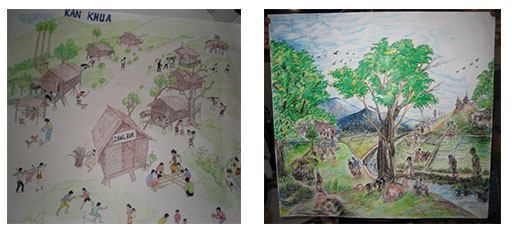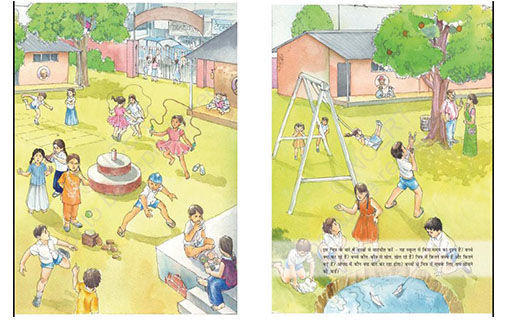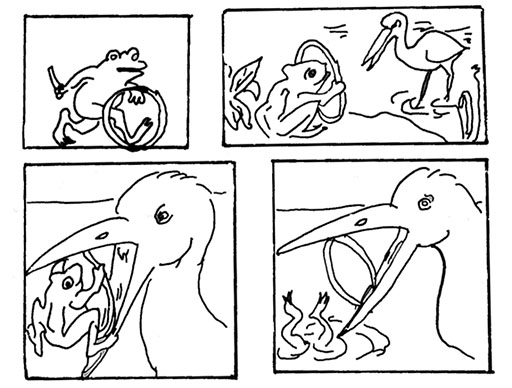2 Using pictures as a prompt for student talk
Read Case Study 1, which describes how a Class I teacher uses pictures to encourage her students to talk about what they know.
Case Study 1: Using pictures to stimulate classroom talk
Ms Priyanka is a Class I teacher in a rural school in Uttar Pradesh. Here she talks of how she employs images of familiar scenes as prompts for classroom talk.
I use pictures [see Figure 1] to encourage my students to talk. The pictures, by local artists, are printed on large sheets of durable paper and coated in plastic. The title of the first picture is ‘My Village’ and the title of the second one is ‘Agriculture’.

First I put the pictures up on the wall. I don’t mention them, but let my students notice and examine them in their own time. Over the next day or two I observe my students talking to one another about the pictures and discussing the details in them.
I then organise a 20-minute session to discuss the two pictures with a group of students each day. Sometimes I take the group outside to do this. I set the rest of the class other quiet work to do at the same time.
I list a number of questions in advance. Some questions are intended to elicit simple descriptions, while others are intended to prompt more exploratory talk, in the form of reasoning, predicting and relating things to the students’ own experience. Here are some examples of each type.
- What is this a picture of?
- Can you describe what you see in the picture?
- What are the people doing?
- Have you ever played these games? Can you explain how to play them?
- Have you ever helped your family in the jum fields?
- What is your favourite food from the fields? How do you prepare that food?
- What part of the picture do you like best? Why exactly?
I listen to each student carefully without correcting or interrupting them. I insist that the other students listen carefully too. By encouraging my students to talk about what they see and know, I learn a lot about them. This helps me to assess their ability and consider ways of supporting or extending them further.
A few of my students are too shy to speak, but they are clearly listening to their classmates. I try to ask them simple questions that allow them to respond with a single word, a nod or a shake of their head to indicate that they understand me.
I always attempt to give my students good models of speaking and listening. I talk clearly, make eye contact with those who respond and ask further questions to indicate my interest in their answers.
Pause for thought
|
Your students will probably be from diverse social, cultural and linguistic backgrounds. The speaking and listening activities that you incorporate into your classroom should draw on the varied knowledge that your students bring to school. This is particularly true for students whose home language is different from the school language. Notice how the picture prompts used in Case Study 1 would have been familiar scenes to all of Ms Priyanka’s students. Be aware that students who are silent may still be participating by listening, thinking and learning.
In the following activity you will use pictures to encourage speaking and listening among your students.
Activity 2: A picture-based group discussion
You can use any pictures from your textbook or from other sources in your school or community for this activity.
Using Case Study 1 for ideas, plan a lesson in which you use a picture or a series of pictures to encourage your students to talk about what they see or imagine to be happening, relating it to their knowledge and experience.
Before you plan the lesson, do the following:
- Think about how you will organise the activity. Consider whether it will involve pairs, small groups or the whole class, and whether it will take place indoors or outdoors.
- Brainstorm with a colleague the types of questions you could ask your students.
The following questions are based on the pictures in Figure 2. You will need to devise other questions depending on the images you use and the age of the class you are teaching:
- Description questions:
- What do you think is happening in this picture?
- What are the children doing?
- How many girls are there? How many boys? How many adults?
- What colours can you see?
- Reasoning questions:
- Point to some of the adults and ask, ‘Who do you think they are, and what are they saying to each other?’
- Point to some of the children and ask, ‘
- What do you think they are saying?’
- What is the weather or the season? How do you know?
- What time of day do you think it is? Why?
- Is it quiet or noisy? How can you tell?
- Do you think the boy who is eating can see the girls skipping from where he is sitting?
- Are the children sad or happy? How can you tell?
- Why do the girls and boys play different games?
- Does the girl like the loud noise in her ear?
- Prediction questions:
- What will happen when the boy shoots his sling shot?
- Will the boy catch the ball?
- What do you think will happen next?
- Relating the picture to the students’ own experience:
- Does your school compound look like this?
- Do you play these games?
- What games do you like to play?
- What would you like to do if you were in the playground?

Pause for thought Once you have undertaken this activity with your class, answer these questions:
|
Read Resource 2, ‘Using questioning to promote thinking’, to learn more about using questions in your teaching plans and activities.
In the next activity, you will use pictures to encourage your students to make up and tell stories in the classroom.
Activity 3: A story from pictures
Look at the four pictures in Figure 3. Make up a story that relates to the pictures. It can be as short or as long as you like, and can include dialogue.
Tell your story to a colleague. What did they think of it?

Now try a picture-based storytelling activity with your students. You can use any series of pictures for this purpose – from a book, magazine or newspaper, or drawn by yourself, a friend or a colleague.
Begin by modelling the activity by telling your own short story about the picture sequence in Figure 3. Then arrange your students in pairs or groups and invite them to make up a different story using the same picture prompts. Pair or group students with the same home language together so that they can prepare to tell the story in that language. Encourage them to use different voices and gestures if possible.
When everyone is ready, ask your students to tell their story to another pair or group, or to the whole class. Allow time to discuss the ways the home language stories could be translated into the school language too.
Pause for thought
|
1 Talking and learning
